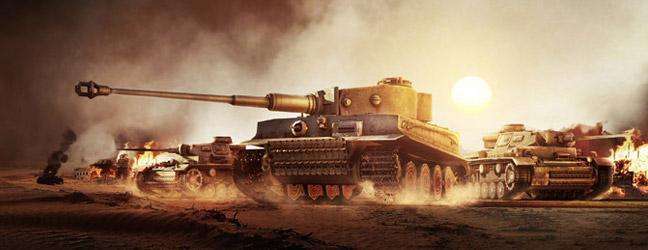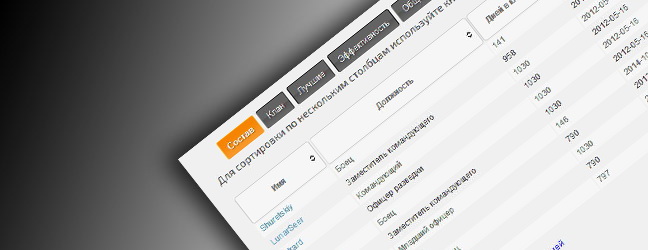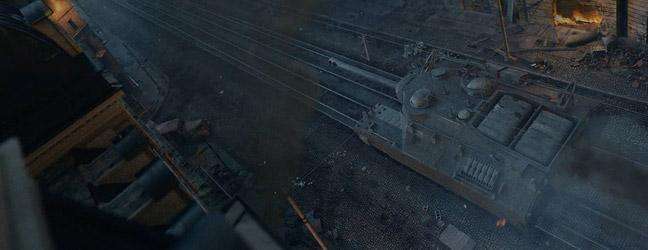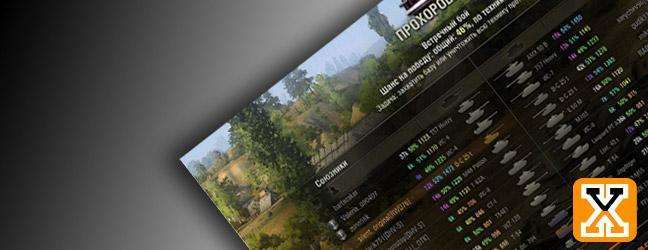Sturmpanzers.
Дата: 18.06.2020 17:39:09
The_Chieftain:  The German Army in WW2 had historically been more than
willing to mount a large gun on an armored, tracked chassis, to use
it in a direct fire role. Initially, the Heavy Infantry Gun
(s.I.G.33) was used, and especially by the standards of 1940, it
proved to have quite the bang. Newsreels showed a single s.I.G.33
on Panzer I chassis demolishing quite efficiently with but a single
round a house in France.
The German Army in WW2 had historically been more than
willing to mount a large gun on an armored, tracked chassis, to use
it in a direct fire role. Initially, the Heavy Infantry Gun
(s.I.G.33) was used, and especially by the standards of 1940, it
proved to have quite the bang. Newsreels showed a single s.I.G.33
on Panzer I chassis demolishing quite efficiently with but a single
round a house in France. Other photographs, similarly, show larger
vehicles later in the war being used as direct fire
artillery.
Other photographs, similarly, show larger
vehicles later in the war being used as direct fire
artillery.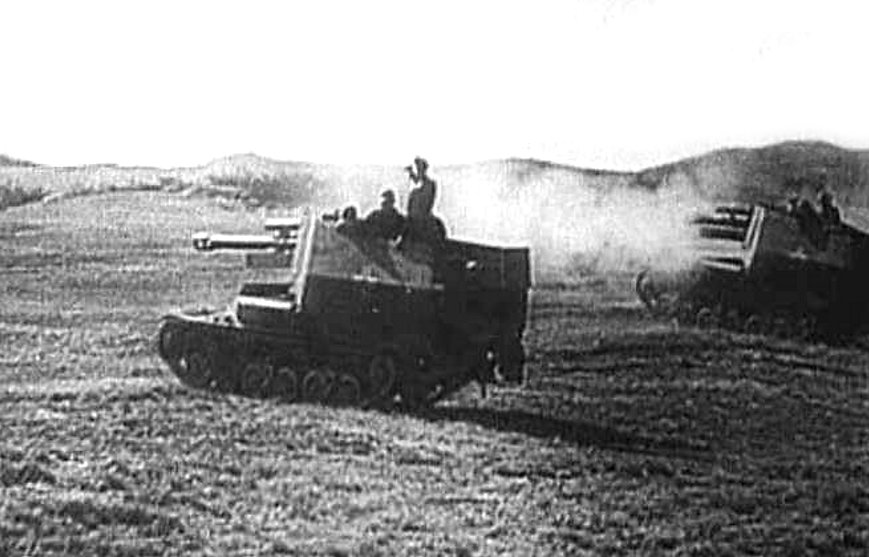 However, these various vehicles
were still categorized as artillery, not as assault guns. They did
not have the armor of the Sturmgeschutz vehicles, and the Germans
knew it. Thus, if you wanted a really big bang, you needed to fire
the round from some distance away to do it in safety,
alternatively, 7.5cm from the better armored Sturmgeschutz and
occasional 105mm from Sturmhaubitze would be available if the
vehicle needed to be closer.This was fine for a while, as the
battlefield normally allowed for such a combination, but the plan
fell a cropper of the fighting in Stalingrad. Big, solid buildings,
combined with short lines of fire meant that the Germans needed to
have a combination of big armor with a big gun, not one or the
other. If it meant that the vehicle was lethargic or had only a
short effective range, so be it.It did not take long for the
solution to be found. Enter the Sturminfanteriegeschutz 33. Alkett
designed it in two days in late September 1942, by basically taking
the StuG III hull, s.I.G. 33/1 15cm gun, and designing a rather
simple box superstructure. The resulting vehicle was ugly, but it
came with 8cm of frontal armor, and a reasonably big
round.
However, these various vehicles
were still categorized as artillery, not as assault guns. They did
not have the armor of the Sturmgeschutz vehicles, and the Germans
knew it. Thus, if you wanted a really big bang, you needed to fire
the round from some distance away to do it in safety,
alternatively, 7.5cm from the better armored Sturmgeschutz and
occasional 105mm from Sturmhaubitze would be available if the
vehicle needed to be closer.This was fine for a while, as the
battlefield normally allowed for such a combination, but the plan
fell a cropper of the fighting in Stalingrad. Big, solid buildings,
combined with short lines of fire meant that the Germans needed to
have a combination of big armor with a big gun, not one or the
other. If it meant that the vehicle was lethargic or had only a
short effective range, so be it.It did not take long for the
solution to be found. Enter the Sturminfanteriegeschutz 33. Alkett
designed it in two days in late September 1942, by basically taking
the StuG III hull, s.I.G. 33/1 15cm gun, and designing a rather
simple box superstructure. The resulting vehicle was ugly, but it
came with 8cm of frontal armor, and a reasonably big
round.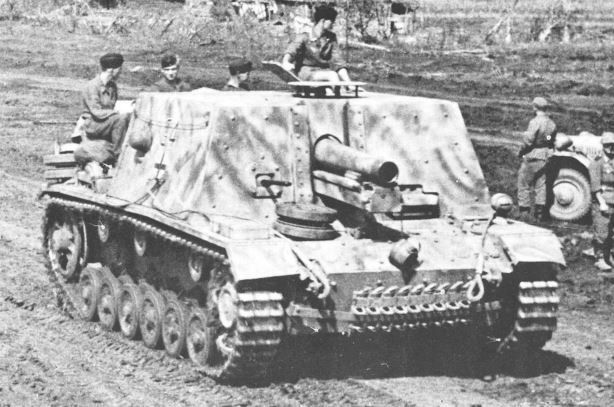 24 examples were built and issued,
whilst work began on a more purpose-designed vehicle. Based, this
time, on the Panzer IV chassis, the 15cm gun was mounted in a
better protected and more flexible ball mount, giving 15 degrees of
traverse as opposed to the 3 degrees on the prior vehicle. The
frontal armor was a very hefty 10cm sloped at 38 degrees. In
addition, later vehicles came with a ball mount for a machinegun
for self defense. After some debate, followed by an arbitrary
decision by Hitler, this vehicle was given to the Panzer Arm, and
this necessitated a name change to Sturmpanzer. For some reason
often termed “Brummbar” today, the Germans actually called it
“Stupa”. This vehicle proved quite successful, with just over 300
being built on a combination of new and re-used hulls starting
April of 1943.
24 examples were built and issued,
whilst work began on a more purpose-designed vehicle. Based, this
time, on the Panzer IV chassis, the 15cm gun was mounted in a
better protected and more flexible ball mount, giving 15 degrees of
traverse as opposed to the 3 degrees on the prior vehicle. The
frontal armor was a very hefty 10cm sloped at 38 degrees. In
addition, later vehicles came with a ball mount for a machinegun
for self defense. After some debate, followed by an arbitrary
decision by Hitler, this vehicle was given to the Panzer Arm, and
this necessitated a name change to Sturmpanzer. For some reason
often termed “Brummbar” today, the Germans actually called it
“Stupa”. This vehicle proved quite successful, with just over 300
being built on a combination of new and re-used hulls starting
April of 1943.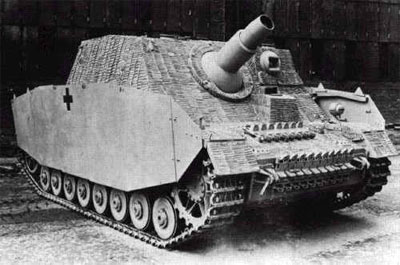 This was, however, still not enough armor and not
enough bang!A requirement came out in May of 1943 for something
capable of werfing 38cm shells. If it were not for the armored
vehicle, the Kriegsmarine’s Raketentauchgranate, rocket propelled
diving grenate, would have probably died in complete obscurity.
Originally to be used as an anti-submarine depth charge launcher,
it simply didn’t have the range or reliability required for the
job. As a result, only a few were made, used in land fortifications
in Denmark and Norway. It was concluded that however ineffective
the system may have been against submarines, it would likely do
quite a number on ships, so they were installed in the coastal
defense role. Two such weapons still exist, one each in Denmark and
Norway.
This was, however, still not enough armor and not
enough bang!A requirement came out in May of 1943 for something
capable of werfing 38cm shells. If it were not for the armored
vehicle, the Kriegsmarine’s Raketentauchgranate, rocket propelled
diving grenate, would have probably died in complete obscurity.
Originally to be used as an anti-submarine depth charge launcher,
it simply didn’t have the range or reliability required for the
job. As a result, only a few were made, used in land fortifications
in Denmark and Norway. It was concluded that however ineffective
the system may have been against submarines, it would likely do
quite a number on ships, so they were installed in the coastal
defense role. Two such weapons still exist, one each in Denmark and
Norway.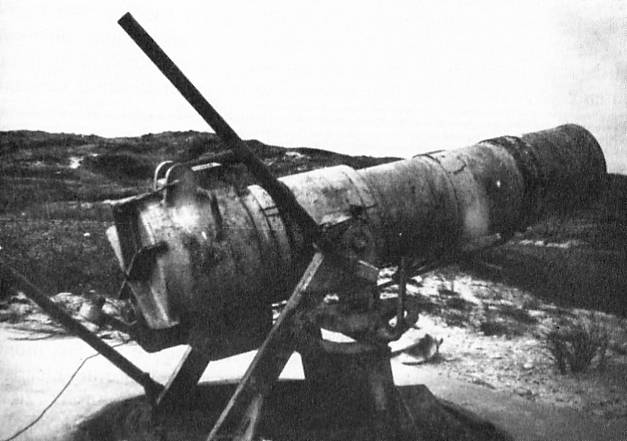 Still the weapon was, relatively
speaking, small and compact enough that it could be reasonably
mounted onto an armored vehicle. A big armored vehicle, mind, but
an armored vehicle. The Tiger I chassis was selected and
construction was started using vehicles returned to the factory for
rebuild. With 15cm of frontal armor sloped at 45 degrees, this
vehicle was not easy on the Tiger’s suspension, and it weighed in
at some 64 tons, seven more than the conventional, turreted
vehicle.Commonly known as Sturmtiger or Sturmmoerser, the use of a
nickname was pretty much mandated by the vehicle’s official title:
Sturmmoerserwagen 606/4 mit Raketenwerfer 61. Which is kindof hard
to type, and just a little bit long-winded.
Still the weapon was, relatively
speaking, small and compact enough that it could be reasonably
mounted onto an armored vehicle. A big armored vehicle, mind, but
an armored vehicle. The Tiger I chassis was selected and
construction was started using vehicles returned to the factory for
rebuild. With 15cm of frontal armor sloped at 45 degrees, this
vehicle was not easy on the Tiger’s suspension, and it weighed in
at some 64 tons, seven more than the conventional, turreted
vehicle.Commonly known as Sturmtiger or Sturmmoerser, the use of a
nickname was pretty much mandated by the vehicle’s official title:
Sturmmoerserwagen 606/4 mit Raketenwerfer 61. Which is kindof hard
to type, and just a little bit long-winded.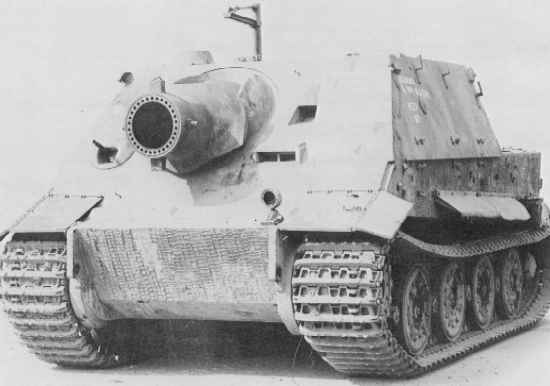 The first two vehicles completed were
quickly dispatched to Warsaw, and the report back from the
commander was not entirely complementary of the project. He
reported that the blast from the round’s detonation was so big that
the vehicle could not be close to the target. As a result, if
engaging from further away from the target, it would make more
sense to have a more lightly armored vehicle. Perhaps the Stupa was
the best compromise.Indeed, the high explosive round carried 125kg
of filler. To put this into perspective, the typical 15cm artillery
round the Germans fired had just over 5.5kg of explosives. The 38cm
HE shell fired from the battleship Bismarck had only a 64kg filler.
This thing made a heck of a bang, with a lethality radius of some
500m.All in all, 18 of the vehicles were built, they were issued to
three Sturm-Moerser-Kompanien, two of which fought in the Ardennes
offensive in December of 1944. However, they proved to have little
effect. Anyone on the receiving end noticed, one American Sherman
commander saying that the round made a hole in the ground the size
of his tank, but one unit missed the jump-off and most of the
vehicles ended up having to be abandoned and destroyed by their
crews. As a result, the vehicles ended up really just being a
historical footnote. Albeit a really cool one. Two vehicles exist
now, one in Germany, and one in Russia
The first two vehicles completed were
quickly dispatched to Warsaw, and the report back from the
commander was not entirely complementary of the project. He
reported that the blast from the round’s detonation was so big that
the vehicle could not be close to the target. As a result, if
engaging from further away from the target, it would make more
sense to have a more lightly armored vehicle. Perhaps the Stupa was
the best compromise.Indeed, the high explosive round carried 125kg
of filler. To put this into perspective, the typical 15cm artillery
round the Germans fired had just over 5.5kg of explosives. The 38cm
HE shell fired from the battleship Bismarck had only a 64kg filler.
This thing made a heck of a bang, with a lethality radius of some
500m.All in all, 18 of the vehicles were built, they were issued to
three Sturm-Moerser-Kompanien, two of which fought in the Ardennes
offensive in December of 1944. However, they proved to have little
effect. Anyone on the receiving end noticed, one American Sherman
commander saying that the round made a hole in the ground the size
of his tank, but one unit missed the jump-off and most of the
vehicles ended up having to be abandoned and destroyed by their
crews. As a result, the vehicles ended up really just being a
historical footnote. Albeit a really cool one. Two vehicles exist
now, one in Germany, and one in Russia
 The German Army in WW2 had historically been more than
willing to mount a large gun on an armored, tracked chassis, to use
it in a direct fire role. Initially, the Heavy Infantry Gun
(s.I.G.33) was used, and especially by the standards of 1940, it
proved to have quite the bang. Newsreels showed a single s.I.G.33
on Panzer I chassis demolishing quite efficiently with but a single
round a house in France.
The German Army in WW2 had historically been more than
willing to mount a large gun on an armored, tracked chassis, to use
it in a direct fire role. Initially, the Heavy Infantry Gun
(s.I.G.33) was used, and especially by the standards of 1940, it
proved to have quite the bang. Newsreels showed a single s.I.G.33
on Panzer I chassis demolishing quite efficiently with but a single
round a house in France. Other photographs, similarly, show larger
vehicles later in the war being used as direct fire
artillery.
Other photographs, similarly, show larger
vehicles later in the war being used as direct fire
artillery. However, these various vehicles
were still categorized as artillery, not as assault guns. They did
not have the armor of the Sturmgeschutz vehicles, and the Germans
knew it. Thus, if you wanted a really big bang, you needed to fire
the round from some distance away to do it in safety,
alternatively, 7.5cm from the better armored Sturmgeschutz and
occasional 105mm from Sturmhaubitze would be available if the
vehicle needed to be closer.This was fine for a while, as the
battlefield normally allowed for such a combination, but the plan
fell a cropper of the fighting in Stalingrad. Big, solid buildings,
combined with short lines of fire meant that the Germans needed to
have a combination of big armor with a big gun, not one or the
other. If it meant that the vehicle was lethargic or had only a
short effective range, so be it.It did not take long for the
solution to be found. Enter the Sturminfanteriegeschutz 33. Alkett
designed it in two days in late September 1942, by basically taking
the StuG III hull, s.I.G. 33/1 15cm gun, and designing a rather
simple box superstructure. The resulting vehicle was ugly, but it
came with 8cm of frontal armor, and a reasonably big
round.
However, these various vehicles
were still categorized as artillery, not as assault guns. They did
not have the armor of the Sturmgeschutz vehicles, and the Germans
knew it. Thus, if you wanted a really big bang, you needed to fire
the round from some distance away to do it in safety,
alternatively, 7.5cm from the better armored Sturmgeschutz and
occasional 105mm from Sturmhaubitze would be available if the
vehicle needed to be closer.This was fine for a while, as the
battlefield normally allowed for such a combination, but the plan
fell a cropper of the fighting in Stalingrad. Big, solid buildings,
combined with short lines of fire meant that the Germans needed to
have a combination of big armor with a big gun, not one or the
other. If it meant that the vehicle was lethargic or had only a
short effective range, so be it.It did not take long for the
solution to be found. Enter the Sturminfanteriegeschutz 33. Alkett
designed it in two days in late September 1942, by basically taking
the StuG III hull, s.I.G. 33/1 15cm gun, and designing a rather
simple box superstructure. The resulting vehicle was ugly, but it
came with 8cm of frontal armor, and a reasonably big
round. 24 examples were built and issued,
whilst work began on a more purpose-designed vehicle. Based, this
time, on the Panzer IV chassis, the 15cm gun was mounted in a
better protected and more flexible ball mount, giving 15 degrees of
traverse as opposed to the 3 degrees on the prior vehicle. The
frontal armor was a very hefty 10cm sloped at 38 degrees. In
addition, later vehicles came with a ball mount for a machinegun
for self defense. After some debate, followed by an arbitrary
decision by Hitler, this vehicle was given to the Panzer Arm, and
this necessitated a name change to Sturmpanzer. For some reason
often termed “Brummbar” today, the Germans actually called it
“Stupa”. This vehicle proved quite successful, with just over 300
being built on a combination of new and re-used hulls starting
April of 1943.
24 examples were built and issued,
whilst work began on a more purpose-designed vehicle. Based, this
time, on the Panzer IV chassis, the 15cm gun was mounted in a
better protected and more flexible ball mount, giving 15 degrees of
traverse as opposed to the 3 degrees on the prior vehicle. The
frontal armor was a very hefty 10cm sloped at 38 degrees. In
addition, later vehicles came with a ball mount for a machinegun
for self defense. After some debate, followed by an arbitrary
decision by Hitler, this vehicle was given to the Panzer Arm, and
this necessitated a name change to Sturmpanzer. For some reason
often termed “Brummbar” today, the Germans actually called it
“Stupa”. This vehicle proved quite successful, with just over 300
being built on a combination of new and re-used hulls starting
April of 1943. This was, however, still not enough armor and not
enough bang!A requirement came out in May of 1943 for something
capable of werfing 38cm shells. If it were not for the armored
vehicle, the Kriegsmarine’s Raketentauchgranate, rocket propelled
diving grenate, would have probably died in complete obscurity.
Originally to be used as an anti-submarine depth charge launcher,
it simply didn’t have the range or reliability required for the
job. As a result, only a few were made, used in land fortifications
in Denmark and Norway. It was concluded that however ineffective
the system may have been against submarines, it would likely do
quite a number on ships, so they were installed in the coastal
defense role. Two such weapons still exist, one each in Denmark and
Norway.
This was, however, still not enough armor and not
enough bang!A requirement came out in May of 1943 for something
capable of werfing 38cm shells. If it were not for the armored
vehicle, the Kriegsmarine’s Raketentauchgranate, rocket propelled
diving grenate, would have probably died in complete obscurity.
Originally to be used as an anti-submarine depth charge launcher,
it simply didn’t have the range or reliability required for the
job. As a result, only a few were made, used in land fortifications
in Denmark and Norway. It was concluded that however ineffective
the system may have been against submarines, it would likely do
quite a number on ships, so they were installed in the coastal
defense role. Two such weapons still exist, one each in Denmark and
Norway. Still the weapon was, relatively
speaking, small and compact enough that it could be reasonably
mounted onto an armored vehicle. A big armored vehicle, mind, but
an armored vehicle. The Tiger I chassis was selected and
construction was started using vehicles returned to the factory for
rebuild. With 15cm of frontal armor sloped at 45 degrees, this
vehicle was not easy on the Tiger’s suspension, and it weighed in
at some 64 tons, seven more than the conventional, turreted
vehicle.Commonly known as Sturmtiger or Sturmmoerser, the use of a
nickname was pretty much mandated by the vehicle’s official title:
Sturmmoerserwagen 606/4 mit Raketenwerfer 61. Which is kindof hard
to type, and just a little bit long-winded.
Still the weapon was, relatively
speaking, small and compact enough that it could be reasonably
mounted onto an armored vehicle. A big armored vehicle, mind, but
an armored vehicle. The Tiger I chassis was selected and
construction was started using vehicles returned to the factory for
rebuild. With 15cm of frontal armor sloped at 45 degrees, this
vehicle was not easy on the Tiger’s suspension, and it weighed in
at some 64 tons, seven more than the conventional, turreted
vehicle.Commonly known as Sturmtiger or Sturmmoerser, the use of a
nickname was pretty much mandated by the vehicle’s official title:
Sturmmoerserwagen 606/4 mit Raketenwerfer 61. Which is kindof hard
to type, and just a little bit long-winded. The first two vehicles completed were
quickly dispatched to Warsaw, and the report back from the
commander was not entirely complementary of the project. He
reported that the blast from the round’s detonation was so big that
the vehicle could not be close to the target. As a result, if
engaging from further away from the target, it would make more
sense to have a more lightly armored vehicle. Perhaps the Stupa was
the best compromise.Indeed, the high explosive round carried 125kg
of filler. To put this into perspective, the typical 15cm artillery
round the Germans fired had just over 5.5kg of explosives. The 38cm
HE shell fired from the battleship Bismarck had only a 64kg filler.
This thing made a heck of a bang, with a lethality radius of some
500m.All in all, 18 of the vehicles were built, they were issued to
three Sturm-Moerser-Kompanien, two of which fought in the Ardennes
offensive in December of 1944. However, they proved to have little
effect. Anyone on the receiving end noticed, one American Sherman
commander saying that the round made a hole in the ground the size
of his tank, but one unit missed the jump-off and most of the
vehicles ended up having to be abandoned and destroyed by their
crews. As a result, the vehicles ended up really just being a
historical footnote. Albeit a really cool one. Two vehicles exist
now, one in Germany, and one in Russia
The first two vehicles completed were
quickly dispatched to Warsaw, and the report back from the
commander was not entirely complementary of the project. He
reported that the blast from the round’s detonation was so big that
the vehicle could not be close to the target. As a result, if
engaging from further away from the target, it would make more
sense to have a more lightly armored vehicle. Perhaps the Stupa was
the best compromise.Indeed, the high explosive round carried 125kg
of filler. To put this into perspective, the typical 15cm artillery
round the Germans fired had just over 5.5kg of explosives. The 38cm
HE shell fired from the battleship Bismarck had only a 64kg filler.
This thing made a heck of a bang, with a lethality radius of some
500m.All in all, 18 of the vehicles were built, they were issued to
three Sturm-Moerser-Kompanien, two of which fought in the Ardennes
offensive in December of 1944. However, they proved to have little
effect. Anyone on the receiving end noticed, one American Sherman
commander saying that the round made a hole in the ground the size
of his tank, but one unit missed the jump-off and most of the
vehicles ended up having to be abandoned and destroyed by their
crews. As a result, the vehicles ended up really just being a
historical footnote. Albeit a really cool one. Two vehicles exist
now, one in Germany, and one in Russia Sturmpanzers.





